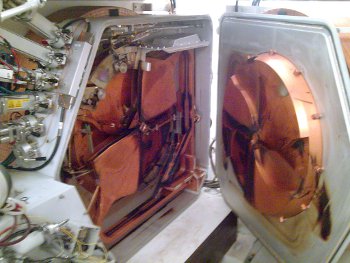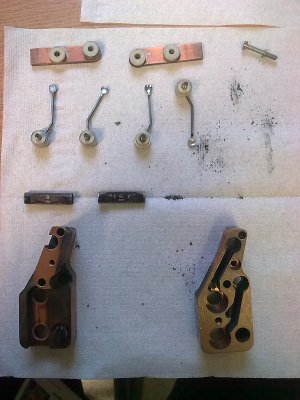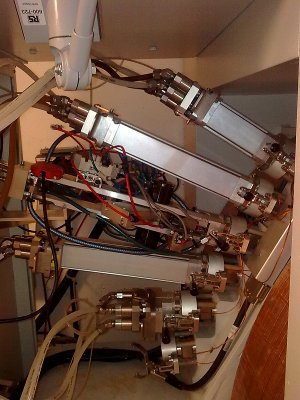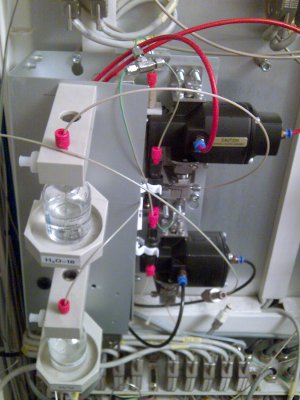 The PETtrace is a cyclotron capable of accelerating protons up to final energies of 16.5 MeV and deuterons up to final energies of 8.4MeV. These energies are used to create the commonly used PET radioisotopes Fluoride-18, Carbon-11, Nitrogen-13, Oxygen-15 and Copper-64.
The PETtrace is a cyclotron capable of accelerating protons up to final energies of 16.5 MeV and deuterons up to final energies of 8.4MeV. These energies are used to create the commonly used PET radioisotopes Fluoride-18, Carbon-11, Nitrogen-13, Oxygen-15 and Copper-64.
 The PETtrace accelerates negative ions (either protons or deuterons depending on desired isotope) generated in an internal Penning Ion Guage ion source. The acceleration takes place vertically, in an average magnetic field of around 1.8Tesla.
The PETtrace accelerates negative ions (either protons or deuterons depending on desired isotope) generated in an internal Penning Ion Guage ion source. The acceleration takes place vertically, in an average magnetic field of around 1.8Tesla.
Acceleration voltages are about 35kV with the RF frequency set by crystal oscillators at 27.2MHz for protons and 27.8MHz for deuterons. Two trim flaps are located in the tank to tune the resonant circuit, and compensate for any thermal drift in the dees. All RF processes are controlled by the remotely located RF Power Generator, which also contains the Power Amplifier Tube (4CW25000A Power Tetrode).
Extraction is achieved by carbon extraction foils, which strip the electrons off the accelerated ions, thus reversing the polarity of the charge, and altering the direction of orbit. By careful positioning of the extraction foils, the beam can be steered onto a particular target. This machine is capable of dual beam production, by letting part of the beam through two seperate extraction foils to two seperate targets simultaneously. However, we do not use this facility at the WBIC.
 The compliment of targets on the PETtrace consist of:
The compliment of targets on the PETtrace consist of:
2x Carbon-11, using 14-N(p,a)11-C reaction in Aluminium target body (gas target)
1x Oxygen-15, using 14-N(d,n)15-O reaction in Aluminium target body (gas target)
2x Fluoride-18, using 18-O(p,n)18-F reaction in Silver target body (liquid target)
1x Copper-64, using 64-Ni(p,n)64-Cu reaction on Gold target (Nickel plated, solid target)
The irradiated target material is then transferred outside the cyclotron vault to be processed. In the case of the Carbon-11 and Oxygen-15, these gases are transferred to a lead-lined Process Cabinet, containing mass flow instrumentation and filtration. The [C-11]CO2 produced in the target can be converted into [C11]-CO, [C11]-HCN or transferred as [C11]CO2 direct to the radiochemistry lab, for production of the [C11]Methyl Iodide precursor. The Oxygen-15 pipework is split into three lines for simultaneous production of [O-15]CO, [O-15]O2 and [O-15]H2O and directed towards the WBIC PET scanner.
 The Fluoride-18 is delivered, in water, direct the the radiochemistry lab under a carrier gas of helium. There is can be directed to one of seven locations, but by default, is directed to the Coincidence FDG synthesiser.
The Fluoride-18 is delivered, in water, direct the the radiochemistry lab under a carrier gas of helium. There is can be directed to one of seven locations, but by default, is directed to the Coincidence FDG synthesiser.
There have been a number of modifications made to the original specification. For example, the liquid target has been modified to operate at a higher fill pressure, without the originally intended reflux, allowing us to run with a higher beam current on target, resulting in a higher target yield. As well as this, the original liquid target filling station had a number of valves underrated for our application (target pressure of up to 130psi), and contained valve seats made of a fluoropolymer. This has the result of potentially reducing specific activity in the F-18 target. The target station has been replaced with Swagelok valves with Ultra High Molecular Weight Polyethylene valve seats, which can withstand the high pressure of the target.
